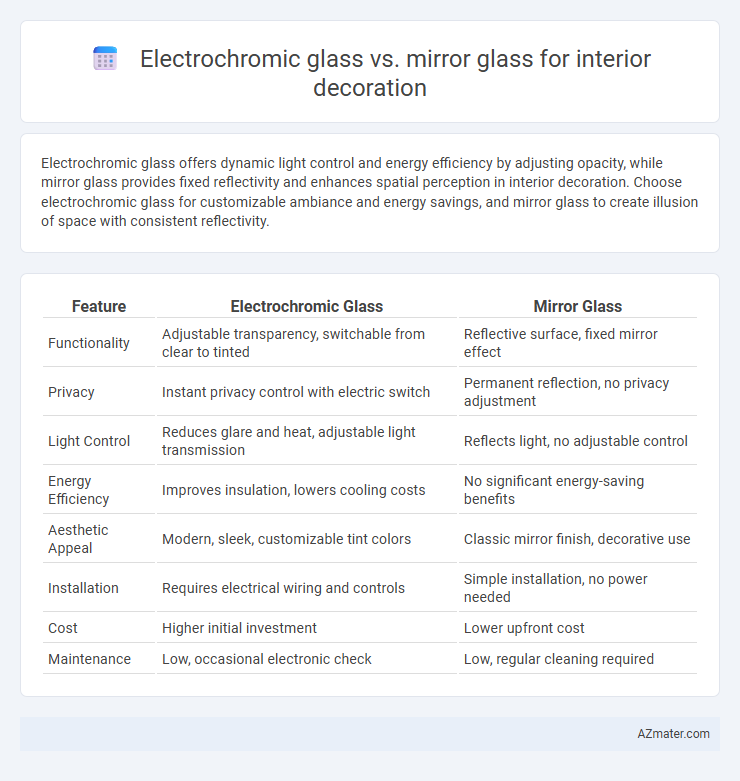Electrochromic glass offers dynamic light control and energy efficiency by adjusting opacity, while mirror glass provides fixed reflectivity and enhances spatial perception in interior decoration. Choose electrochromic glass for customizable ambiance and energy savings, and mirror glass to create illusion of space with consistent reflectivity.
Table of Comparison
| Feature | Electrochromic Glass | Mirror Glass |
|---|---|---|
| Functionality | Adjustable transparency, switchable from clear to tinted | Reflective surface, fixed mirror effect |
| Privacy | Instant privacy control with electric switch | Permanent reflection, no privacy adjustment |
| Light Control | Reduces glare and heat, adjustable light transmission | Reflects light, no adjustable control |
| Energy Efficiency | Improves insulation, lowers cooling costs | No significant energy-saving benefits |
| Aesthetic Appeal | Modern, sleek, customizable tint colors | Classic mirror finish, decorative use |
| Installation | Requires electrical wiring and controls | Simple installation, no power needed |
| Cost | Higher initial investment | Lower upfront cost |
| Maintenance | Low, occasional electronic check | Low, regular cleaning required |
Understanding Electrochromic Glass
Electrochromic glass offers dynamic light control by adjusting its tint in response to electrical voltage, enhancing energy efficiency and privacy within interior spaces. Unlike traditional mirror glass, which reflects light and creates visual separation, electrochromic glass provides customizable transparency without obstructing views, making it ideal for modern interior design. Integration of electrochromic technology in interior decoration enables versatile ambiance management, reducing reliance on blinds or curtains while improving natural light utilization.
Key Features of Mirror Glass
Mirror glass offers high reflectivity and excellent clarity, making it ideal for enhancing interior spaces by creating an illusion of depth and increasing natural light. Its surface is typically coated with a metallic layer, providing durability and resistance to scratching, which is essential for maintaining aesthetic appeal in high-traffic areas. Unlike electrochromic glass, mirror glass does not change transparency, making it a static but reliable option for decorative and functional interior applications.
Aesthetic Appeal: Modern vs Classic
Electrochromic glass offers a sleek, modern aesthetic with its ability to dynamically change transparency, creating versatile light and privacy effects suited for contemporary interiors. Mirror glass provides a classic, timeless appeal by reflecting space and light, adding elegance and depth to traditional decor styles. Both materials enhance interior design, but electrochromic glass emphasizes innovation and adaptability, while mirror glass highlights sophistication and permanence.
Energy Efficiency and Smart Technology
Electrochromic glass enhances energy efficiency by dynamically controlling solar heat and glare, reducing HVAC loads and improving indoor comfort through smart, adjustable tinting. Mirror glass offers passive energy benefits by reflecting light and heat but lacks adaptive technology and real-time control, limiting its effectiveness in changing environmental conditions. Integration of electrochromic glass with smart home systems optimizes energy savings and user convenience, positioning it as a superior solution for modern interior decoration focused on sustainability and innovation.
Privacy Solutions in Interior Spaces
Electrochromic glass offers dynamic privacy control by electronically adjusting its opacity, making it ideal for interior spaces requiring flexible privacy solutions without sacrificing natural light. Mirror glass provides a static privacy option by reflecting light and obscuring view from one side, best suited for areas where consistent privacy is needed. Choosing between electrochromic and mirror glass depends on the desired balance of privacy flexibility, light transmission, and aesthetic preference in interior decoration.
Light Control and Glare Reduction
Electrochromic glass offers dynamic light control by adjusting transparency levels to optimize natural illumination and reduce glare in real-time, enhancing comfort and energy efficiency in interior spaces. Mirror glass provides static glare reduction by reflecting light, creating privacy and limiting brightness but lacks adaptability to changing lighting conditions. Choosing electrochromic glass maximizes daylight modulation and visual comfort, making it superior for advanced interior light management compared to traditional mirror glass.
Maintenance and Durability
Electrochromic glass offers superior durability with its scratch-resistant surface and minimal maintenance requirements, as it can be easily cleaned using standard glass cleaners without risk of damage. Mirror glass, while aesthetically appealing, demands frequent cleaning to prevent tarnishing and is more susceptible to scratches and moisture damage, impacting its long-term durability. Choosing electrochromic glass enhances interior decoration longevity and reduces maintenance efforts due to its robust, self-tinting technology and resilient materials.
Cost Comparison and Value
Electrochromic glass, with prices typically ranging from $100 to $200 per square foot, offers dynamic light control and energy efficiency, making it a high-value investment despite its higher upfront cost compared to mirror glass, which generally costs $30 to $50 per square foot. Mirror glass provides a more affordable decorative option with reflective aesthetics but lacks the functional benefits of tint adjustment and privacy control found in electrochromic glass. When evaluating cost versus value, electrochromic glass enhances interior flexibility and long-term energy savings, whereas mirror glass serves primarily as a budget-friendly decorative element.
Application Ideas for Interior Design
Electrochromic glass offers dynamic light control and privacy, making it ideal for office partitions, conference rooms, and modern living spaces that benefit from adaptable ambiance and energy efficiency. Mirror glass enhances interior decoration by providing depth and brightness, perfect for bedrooms, bathrooms, and entryways, where spatial illusion and reflective aesthetics elevate the design. Integrating electrochromic glass in smart homes allows seamless transition between transparency and opacity, while mirror glass serves as a stylish focal point or functional element in luxury interior settings.
Future Trends in Decorative Glass
Electrochromic glass offers dynamic light modulation and energy efficiency by changing tint in response to electrical signals, making it ideal for smart interior environments. Mirror glass provides reflective surfaces that enhance space perception and add aesthetic depth but lacks adaptive functionality. Future trends in decorative glass prioritize integration of electrochromic technology with advanced coatings and smart controls to create versatile, interactive interiors that balance privacy, natural light, and energy savings.

Infographic: Electrochromic glass vs Mirror glass for Interior decoration
 azmater.com
azmater.com